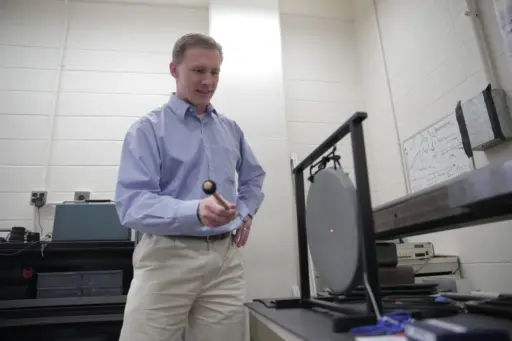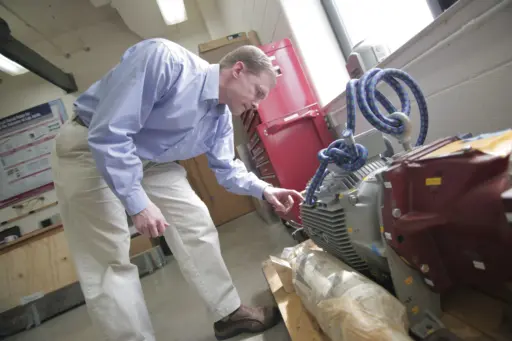Among his many research, teaching and outreach duties, nuclear engineering and engineering physics Associate Professor Matt Allen shoots lasers at a traditional East Asian gong in the name of science.
Allen, who leads the Structural Dynamics Lab, hopes his gong research will help the U.S. Air Force in its effort to develop an aircraft that could reach hypersonic speeds more than five times the speed of sound.
But what can a gong possibly have to do with hypersonic aircraft? The relationship is nonlinear, so to speak.
 Matt Allen strikes a traditional East Asian gong in his lab and uses a laser to precisely measure the nonlinear vibrations associated with the multiple tones. He is working to compare those measurements with computer models in hopes that one day he will be able to account for nonlinear vibrations like these. The ability to properly account for nonlinearity would be useful for all sorts of industries. Photo: Stephanie Precourt
Matt Allen strikes a traditional East Asian gong in his lab and uses a laser to precisely measure the nonlinear vibrations associated with the multiple tones. He is working to compare those measurements with computer models in hopes that one day he will be able to account for nonlinear vibrations like these. The ability to properly account for nonlinearity would be useful for all sorts of industries. Photo: Stephanie Precourt
Allen studies the mind-boggling complexities of nonlinear structural dynamics. Specifically, Allen is interested in nonlinear vibrations and in experimentally characterizing and accurately modeling those complex vibrations. That’s what the gong is for.
When Allen taps the gong softly, it vibrates at a single, linear, predictable frequency. But if he winds up and really whacks the gong, the tone transforms into a cacophony of different frequencies. These frequencies are exceedingly difficult to predict, or even measure, because they come about due to nonlinear vibration of the gong. This is where the laser becomes handy—when aimed at the gong, the laser precisely measures the nonlinear vibrations associated with the multiple tones. Allen is working to compare those measurements with computer models in hopes that one day they will be able to account for the nonlinear vibrations like these. He aims to accurately predict how a structure like this will move and how its sound will radiate.
That’s important because vibration is destructive, and nonlinear vibration is potentially even more so because of its unpredictability.
But what does all of this have to do with hypersonic aircraft?
Allen explains that modeling the nonlinear vibrations of the gong is a first step toward understanding how similar nonlinear vibrations would affect the thin skin panels on an advanced aircraft that would be subject to huge and fluctuating air pressures. In the past engineers have tried to design these aircraft so the panels are stiff and the vibrations stay small and linear, but at hypersonic speeds the pressures are so large that it has proven impossible to design a structure that is both light enough to carry the required fuel and stiff enough to remain linear. Allen hopes that by understanding, and eventually exploiting, nonlinearity, his research can open up a whole new world of possibilities.
“We hope that we can understand how to use thin panels and exploit the nonlinearity that happens when they vibrate at large amplitude to pump the vibration into high frequencies where it is more quickly dissipated. This is similar to how a gong pumps vibration to high frequencies when struck hard,” Allen says. “In the past, engineers have always designed aircraft and spacecraft so that the vibration stays linear because that is all that current computer models can reliably predict.”
But from a design aspect, nonlinear structures are superior, Allen says—or, they would be if humans were able to use nonlinearity properly.
“For instance, humans are nonlinear,” Allen says. “Your muscles, tendons and joints all behave nonlinearly. It makes us more resilient and tougher, so we can survive impacts and vibration. In contrast, a highly linear structure like a crystal glass responds dramatically to vibration at the right frequencies, shattering when the stresses become large enough.”
 Allen’s lab is full of machines that companies have donated to see if Allen’s group can test or model them. For example, the lab houses a 40-horsepower screw compressor, made from heavy-duty steel parts bolted together. Photo: Stephanie Precourt
Allen’s lab is full of machines that companies have donated to see if Allen’s group can test or model them. For example, the lab houses a 40-horsepower screw compressor, made from heavy-duty steel parts bolted together. Photo: Stephanie Precourt
The ability to properly account for nonlinearity would be useful for all sorts of industries, not just advanced aircraft. As a result, Allen’s lab is full of machines that companies have donated to see if Allen’s group can test or model them. For example, the lab houses a 40-horsepower screw compressor, made from heavy-duty steel parts bolted together. When the motor is running, it produces intense vibrations, which cause microscopic slip in the bolted joints. The nonlinear behavior of these vibrating joints makes them notoriously difficult to predict, so companies are forced to spend a lot of money building prototypes and correcting design flaws late in the design process when changes are expensive.
To understand better how these bolted joints behave, Allen and his students hit a small, hanging metal beam with an instrumented hammer that measures the impact force. The beam is actually two pieces that are bolted together. It’s fitted with sensors that record the nonlinear vibrations that occur around the bolted joints when the beam is struck with the hammer. Allen’s group has developed specialized data analysis methods that allow them to understand these nonlinear vibrations. They compare them to computer models that could one day allow them to predict the nonlinear vibration damping of structures like this, or anything that is assembled with bolts—which is everything from rockets to bridges.
Nonlinearities, damping and uncertainties in the properties of joints like these have been the bane of structural dynamics for decades. It is not an exaggeration to say that if Allen’s work is successful and these nonlinear models are adopted by industry—which is his goal—they could fundamentally alter how such machines are designed.
“Engineers go to a lot of lengths to design everything to be linear so their computer models can predict what will happen,” Allen says. “We’re trying to take that analysis to the nonlinear world so that we can understand and exploit things that people have avoided or been scared of before. We are close to having a set of tools that will allow you to predict the response of these nonlinear structures, so you can be more aggressive in design and even exploit nonlinearity to make quieter, more durable structures.”